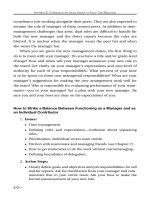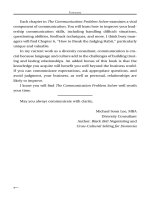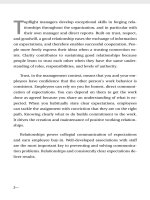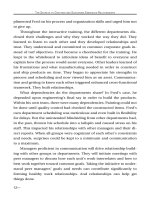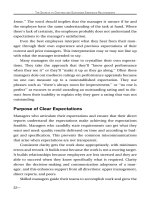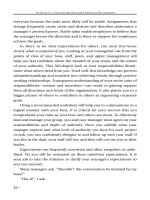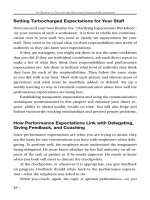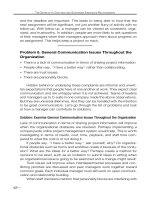chap05 the communication process 2107
Bạn đang xem bản rút gọn của tài liệu. Xem và tải ngay bản đầy đủ của tài liệu tại đây (2.56 MB, 27 trang )
5
The Communication Process
McGraw-Hill/Irwin
© 2004 The McGraw-Hill Companies, Inc., All Rights Reserved.
The Communications Process
Fields of Experience
Source /
Sender
Encoding
Channel
MESSAGE
Decoding
Noise
Response Feedback Loop
Receiver /
Audience
Encoding / Decoding Symbols
• Graphic
– Pictures
– Drawings
– Charts
• Musical
– Arrangement
– Instrumentation
– Voice or chorus
• Verbal
– Spoken word
– Written word
– Song lyrics
• Animation
– Action/motion
– Pace /speed
– Shape/Form
Experiential Overlap
Different Worlds
Sender
Sender
Experience
Experience
Receiver
Receiver
Experience
Experience
Moderate Commonality
Sender
Sender
Experience
Experience
Receiver
Receiver
Experience
Experience
High Commonality
Sender
Sender
Experience
Experience
Receiver
Experience
Semiotics
Three Components of a marketing message
Object
Brand such as Marlboro
Sign or symbol
representing intended
meaning (Cowboy)
Interpretant/
intended meaning
(masculine,rugged
individualistic)
What is the symbolic meaning of the Snuggle
bear?
Two Types of Channels
• Direct (Personal)
– One-on-one
– One to group
– Team to group
• Indirect (Media)
– Paid media
– Unpaid media
– Special media
Human Communicators
• Verbal
– Vocabulary
– Grammar
– Inflection
• Nonverbal
– Gestures
– Facial expression
– Body language
Levels of Audience Aggregation
Mass Markets
Market Segments
Niche Markets
Small Groups
Individuals
Models of the Response Process
Models
Stages
AIDA
Hierarchy of
Innovation
Information
model
effects model
adoption
Processing
Attention
Awareness
Awareness
Presentation
Cognitive
Attention
Knowledge
Interest
Affective
Interest
Linking
Comprehension
Yielding
Preference
Desire
Conviction
Evaluation
Retention
Trial
Behavioral
Action
Purchase
Adoption
Behavior
Advertising is used to make consumers
aware of new products and their features
Models of Obtaining Feedback
Persuasion Process
Effectiveness Test
Circulation reach
Exposure, presentation
Listener, reader,
Viewer recognition
Attention
Recall, checklists
Comprehension
Brand attitudes,
Purchase intent
Message acceptance/
yielding
Recall over time
Retention
Inventory, POP
Consumer panel
Purchase behavior
An Alternative Response Hierarchy
High
High
Low
Learning Model
Low Involvement
Model
Cognitive
Affective
Conative
Dissonance/
Attribution Model
Low
Perceived product
differentiation
Topical Involvement
Conative
Affective
Cognitive
Cognitive
Conative
Affective
An ad for a low involvement product
Involvement Concept
Possibleresults
results
Possible
ofinvolvement
involvement
of
Antecedentsof
of
Antecedents
involvementderived
derived
involvement
fromthe
theliterature
literature
from
Personfactors
factors
Person
Needs
--Needs
Importance
--Importance
Interest
--Interest
Values
--Values
Objector
orstimulus
stimulusfactors
factors
Object
Differentiationof
of
--Differentiation
alternatives
alternatives
Sourceof
ofcommunication
communication
--Source
Contentof
of
––Content
communication
communication
Situationalfactors
factors
Situational
-Purchase/use
-Purchase/use
-Occasion
-Occasion
Involvement
Involvement
Withadvertisements
advertisements
With
Withproducts
products
With
Withpurchase
purchasedecisions
decisions
With
Elicitationof
of
Elicitation
counterargumentsto
to
counterarguments
ads
ads
Effectivenessof
ofad
adto
to
Effectiveness
inducepurchase
purchase
induce
Relativeimportance
importanceof
of
Relative
theproduct
productclass
class
the
Perceiveddifferences
differences
Perceived
productattributes
attributes
ininproduct
Preferenceof
ofaa
Preference
particularkind
kind
particular
Influenceof
ofprice
priceon
on
Influence
brandchoice
choice
brand
Amountof
ofinformation
information
Amount
onsearch
search
on
Timespend
spend
Time
deliberatingalternatives
alternatives
deliberating
Typeof
ofdecision
decisionrule
rule
Type
usedininchoice
choice
used
Low
Involvement
High
Involvement
Foote, Cone & Belding Grid
Thinking
Feeling
1
2
Informative
Affective
The Thinker
The Feeler
3
4
Habit
Formation
SelfSatisfaction
The Doer
The Reactor
Foote, Cone & Belding Grid
Thinking
1
Informative
High
Involvement
The Thinker
Car-house-furnishings-new products
Model: Learn-feel-do (economic?)
Possible implications
Test:
Recall diagnostics
Media: Long copy format
Reflective vehicles
Creative: Specific information
Demonstration
Foote, Cone & Belding Grid
Feeling
2
Affective
High
Involvement
The Feeler
Jewelry-cosmetics-fashion goods
Model: Feel-learn -do (psychological?)
Possible implications
Test:
Attitude change
Emotional arousal
Media: Large space
Image specials
Creative: Executional
Impact
Foote, Cone & Belding Grid
Thinking
3
Habit formation
Low
Involvement
The Doer
Food-household items
Model: Do-learn-feel (responsive?)
Possible implications
Test:
Sales
Media: Small space ads
10-second ID’s
Radio; Point of Sale
Creative: Reminder
Foote, Cone & Belding Grid
Feeling
4
Self-satisfaction
Low
Involvement
The Reactor
Cigarettes, liquor, candy
Model: Do-feel-learn (social?)
Possible implications
Test:
Sales
Media: Billboards
Newspapers
Point of Sale
Creative: Attention
Cognitive Response
¾ A method for examining consumers’
cognitive processing of advertising
messages by looking at their cognitive
responses to hearing, viewing, or
reading communications
¾ Examines types of thoughts that are
evoked by an advertising message
A Model of Cognitive Response
Exposure
Exposureto
to
advertisement
advertisement
Cognitive Responses
Attitudes
Product/message
Product/message
thoughts
thoughts
Brand
Brandattitudes
attitudes
Source-oriented
Source-oriented
thoughts
thoughts
Ad
Adexecution
execution
thoughts
thoughts
Purchase
Purchase
intention
intention
Attitude
Attitudetowards
towards
the
advertisement
the advertisement
Cognitive Response Categories
¾ Product/Message Thoughts
Counter arguments, support
arguments
¾ Source - Oriented Thoughts
Source derogation – source
bolstering
¾ Ad – Execution Thoughts
Thoughts about the ad itself
Affect attitude toward the ad
Important determinant of
advertising effectiveness
The Elaboration Likelihood Model
Focuses on the way consumers respond to
persuasive messages based on the amount and
nature of elaboration or processing of information
Routes to attitude change
¾ Central route to persuasion – ability and motivation
to process a message is high and close attention is
paid to message content
¾ Peripheral route to persuasion – ability and
motivation to process a message is low and receiver
focuses more on peripheral cues rather than
message content
Central processing usually occurs for high
involvement products

